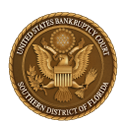(A) Manner of Setting Examination. No order will be necessary to authorize an examination pursuant to Bankruptcy Rule 2004, or to require production of documents or ESI at the examination. Examinations may be scheduled by filing the Local Form “Notice of Rule 2004 Examination” and serving the notice on the trustee, the debtor, the debtor’s attorney and the party to be examined, and, if applicable, the subpoena required by subdivision (D) of this Rule.
(B) Reasonable Notice. The attendance of the examinee and the production of documents or ESI may not be required less than 14 days after actual delivery of the notice, except by agreement of the parties or order of the court. However, an examination may be scheduled on shorter notice if the notice provides that the party to be examined need not file any objection to the short notice but must notify the examining party promptly of the inadequate notice and must offer a reasonable opportunity to be examined on another date. To the extent that a request for production of documents or ESI under this rule may be construed as a request under Bankruptcy Rule 7034, the time to respond is shortened to 14 days.
(C) Motion for Protective Order. An interested party may file, prior to the date of the proposed examination, a motion for protective order stating the reasons for prohibiting, limiting or rescheduling the examination, and the examination shall be stayed until the court rules on the motion.
(D) Subpoena. No subpoena shall be necessary to compel attendance of, or production of documents or ESI from, the debtor at an examination of the debtor, but a Local Form “Subpoena for Rule 2004 Examination” shall be necessary to compel the attendance of, or production of documents or ESI by, a witness other than the debtor.
[Comment: Local Rule 1007-1(F)(17) defines Electronically Stored Information (ESI). Also see Local Form "Subpoena for Rule 2004 Examination" and Local Form "Notice of Rule 2004 Exam". Notwithstanding the broad scope of Bankruptcy Rule 2004, such scope is not without limits and the examinee may file a motion for protective order under section (C) of this rule. On such motion, the court will consider an examinee’s reasons for limiting and/or rescheduling the examination; and the court may – at its discretion – consider proportionality as a factor in ruling on a request for production of documents, or electronically stored information.]
(E) Videotaped Examinations. Examinations may be videotaped. The notice or subpoena must indicate that the examination is to be videotaped and whether it will also be recorded stenographically.
[Comment: See also Bankruptcy Rules 7026-7037 and 9014 and Local Rule 7026-1 (discovery in adversary proceedings and contested matters.)]
| ☞2020 Amendment: Local Rule 2004-1 coincides with Bankruptcy Rule 2004 and details the manner and procedure of conducting an examination of a debtor and other interested parties. The federal subpoena form for a Bankruptcy Rule 2004 examination, Local Form "Notice of a Rule 2004 Examination", and the Local Form "Subpoena for a Rule 2004 Examination" all include reference to “electronically stored information” as a production requirement. The local rule is amended to include the term “electronically stored information” to make the rule consistent with the district’s required forms for a subpoena and notice of a Rule 2004 examination.) |
